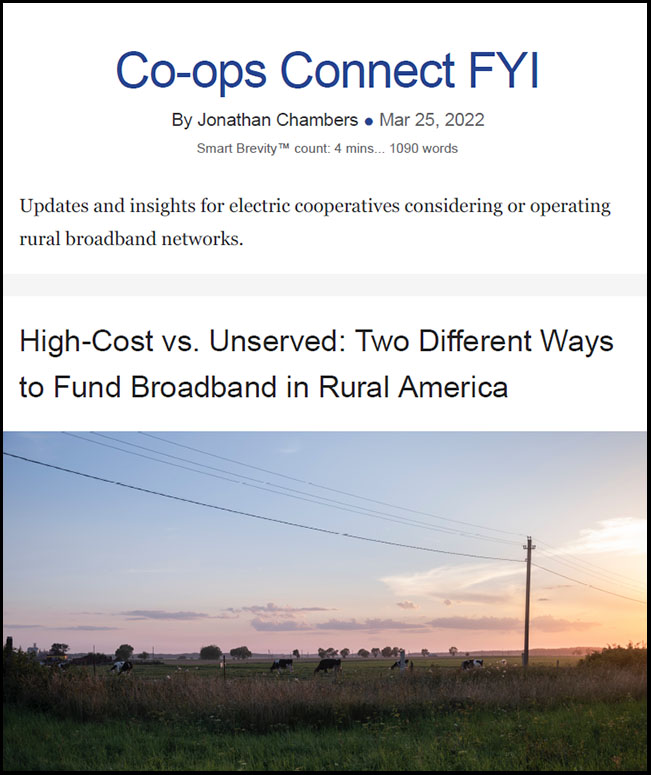High-Cost vs. Unserved: Two Different Ways to Fund Broadband in Rural America
March 25, 2022
The Infrastructure Act contains an opaque yet important provision regarding an enhanced benefit for providing broadband in high-cost areas:
Upon a showing that the applicability of the lower limit under subparagraph A [the $30 rate] to the provision of the affordable connectivity benefit by the provider would cause particularized economic hardship to the provider such that the provider may not be able to maintain the operation of part or all of its broadband network.
Still reading? Here’s why I think that’s important:
An additional $75 per month per broadband subscriber is available through the Affordable Connectivity Program (ACP) to providers serving high-cost areas.
Low-income households and rural, high-cost areas were two of the principal beneficiaries of the Universal Service provisions of the 1996 Telecommunications Act.
- The Infrastructure Act marries the two types of recipients into a single program, the ACP, with a straightforward benefit: $30 for low-income households and $75 for rural, high-cost areas.
- By contrast, the bulk of the Infrastructure Act spending is directed to “unserved” locations.
The bottom line:
Unserved and high-cost are different approaches to rural broadband.
- An unserved approach is about the definition.
- A high-cost approach is about the economics.
I am unaware of any state using a high-cost approach, although it has been the core of FCC Universal Service funding since 1996.
The Unserved Approach
Go deeper:
Nearly all the focus of broadband mapping, including the DATA Act mapping, is based on determining which locations in the country are unserved.
- To the extent there is debate about maps, the debate revolves around self-reporting by ISPs, the validity of speed tests, and the granularity of the data.
- Unserved areas change whenever a new Congress, a new FCC or a new Administration decides to change the definition of broadband.
- Conversely, high-cost areas are those where normal network economics do not justify private investment. The same areas that lacked electricity, also lacked phone service, cable television service, and broadband service. These areas only change slowly as populations shift.
By the numbers: Over the past decade, the prevailing broadband definitions have changed substantially.2010: 4/1 Mbps is broadband.
- 2015: 10/1 Mbps is broadband.
- 2018: 25/3 Mbps is broadband.
- 2021: 100/20 Mbps is broadband.
- I’m willing to bet Gigabit is the government definition for broadband by 2025.
The bottom line:
Focusing on unserved is understandable but short-sighted.
- When you change the definition, you increase or decrease the number of unserved locations.
- When I was at the FCC, there was a commissioner who believed that the digital divide could be solved by definition: Include satellite service in the definition and, presto, no more unserved areas.
The High-Cost Approach
Historically, the FCC has taken the high-cost approach to rural funding. The FCC administers 16 different high-cost programs of over $4 billion in annual spending.
- For the past 10 years, the FCC has used various cost models, the Connect America Cost Model (“CACM” or “CAM”) and the Alternative Connect America Model (“ACAM”), to determine the level of operating subsidy required to support broadband in high-cost areas.
- The FCC adopted a detailed set of assumptions to model the construction, operation, and maintenance of gigabit passive optical network (“GPON”) fiber-to-the-home networks to every location in every census block in the country.
- The depreciation expense for network assets, maintenance, replacement capex, a weighted average cost of capital, as well as the operating expenses for providing telecommunications and broadband service, are used to calculate a monthly expense for every rural census block in the country.
- An assumed revenue for the provision of telecommunications and broadband services, at an affordable price and take rate of 70%, is calculated for location in every rural census block.
Why it matters:
Where the projected revenue in a census block does not cover the projected expense, the census block is categorized as a “high-cost” block.
The amount of the shortfall is calculated to determine the necessary support amount, or subsidy, that would be made available to an eligible telecommunications carrier in the area.
The big picture: In this manner, the FCC was attempting to identify those census blocks where the projected revenue will not cover the expenses associated with the network, as well as provide an additional incentive to build in historically underserved areas.
Generally, high-cost census blocks are those that are sparsely populated (even though topography and terrain are accounted for in the cost models).
- The break-even point for the FCC’s cost model comes in those census blocks with a population density of 15-20 locations per linear mile.
The bottom line:
In recent years, the FCC has deviated from this approach, to mix and match high-cost and unserved (CAF II and RDOF auctions), with generally poor results.
Final Thoughts
The FCC has spent a decade developing expertise in broadband cost modeling. Yet the FCC has too often hidden data from the public view and relied on proprietary data that it will not share with the public.
- Were the FCC to share the CAM or A-CAM, a high-cost map could be used by states or counties. Or, the FCC could produce such a map.
- That map could be used in concert with unserved maps to better direct the tens of billions allocated for rural broadband.
Why it matters:
- High-cost and unserved programs are meant to be complementary:
- – Unserved programs are typically structured as capex reimbursement.
- – High-cost programs are designed as operating subsidies.
- But states are treating high-cost programs as if they are competitive with, rather than complementary to unserved programs. For example, some state programs are prohibiting ARPA funding in RDOF areas, even though it is permitted under Treasury guidance.
- NTIA may divert the Infrastructure Act money intended for rural areas and use it for municipal broadband to unserved households. There has been a tendency in past funding decisions to pit rural against urban, to pit rural interests against those of the urban poor.
The bottom line:
The ACP takes a small step to address a different type of divide in America. It may one day be the most important broadband provision of the Infrastructure Act.

